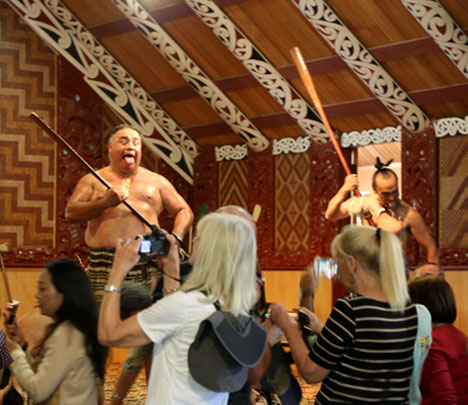Te Puia
Although there are many interesting things to see in Rotorua, our time was limited, so we had decided to spend the day at the
Te Whakarewarewa Thermal Reserve about 2 miles from the city center. There are actually 2 attractions here which are right next to
each other - Te Puia and the Whakarewarewa Thermal Village. They used to be one entity, but in 1997 the village separated from the
Māori Arts & Crafts Institute which later became Te Puia. The village is reputed to be more authentic, but Te Puia attracts most
of the tourists.
It was difficult to choose which place to go, but in the end we decided on Te Puia because the grounds include the Pohutu geyser. At
the village, you can only view the geyser from a distance. Te Puia also has a kiwi house, and we were hoping to see one of these
elusive birds. Both attractions include cultural performances and the opportunity to eat a hangi meal where the food is placed in a
basket and steamed over a geyser.
This was our first view of the Pohutu geyser after entering the park.
We stopped first at the kiwi house, but it was disappointing. Day and night are reversed in kiwi viewing houses because the birds
are active at night and the hope is that if it is dark in the viewing house, they will make an appearance. Daytime for the birds is
at night when no one is around and the lights are turned on. On this day, the kiwi was holed up in his
burrow. Apparently, this was not unexpected behavior because a camera had been set up inside the burrow and images of the kiwi
were projected on a television. The quality of the pictures was not good, though, so we gave up and headed down for a closer
look at the geyser. On the way we passed several pits of bubbling mud.
The geyser certainly did not disappoint. During our visit, it consistently sent billows of steam and hot water high into the air.
As you can see, you can get quite close to the action.
There is thermal activity pretty much everywhere you look.
The run-off from the geyser is rather colorful.
We also enjoyed the cultural performance. A conch shell is blown and a warrior approaches to challenge
the honorary male chief of the group that will be attending the performance. A volunteer from the audience
is asked to assume this role. After the challenge, the warrior makes a sweeping motion with his hand, slaps
his thigh, turns his back to the crowd and pulls on an imaginary rope to lead the audience into the marae.
Next a female host performs a welcome chant called a karanga.
Inside the marae, the group sang, danced, chanted, and demonstrated the skills warriors possess.
This is a work that was in progress at the woodworking school that is part of Te Puia. There is also
a weaving school.
After a visit to the gift shop, we headed on to our next destination, beautiful Lake Taupo.
Best of all, we finally had a room with a lovely view. This picture was taken from our
room at sunset that evening.























